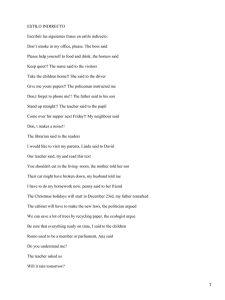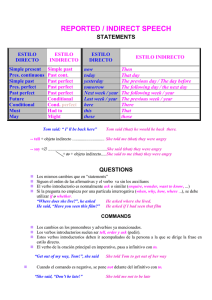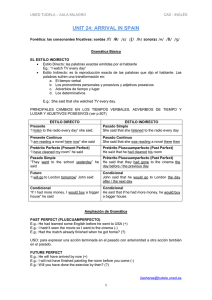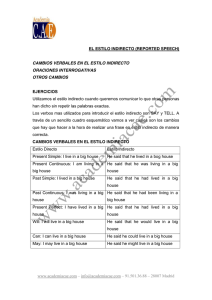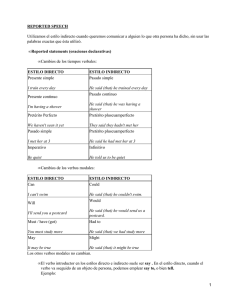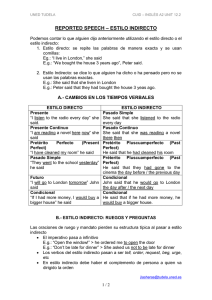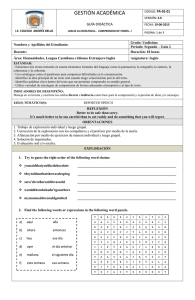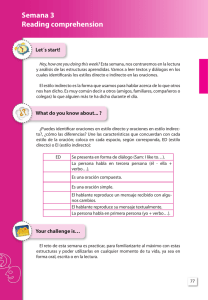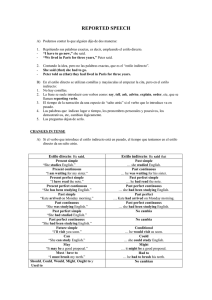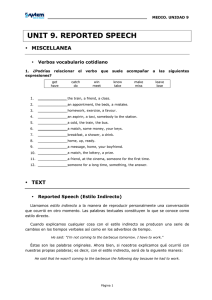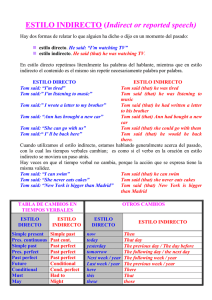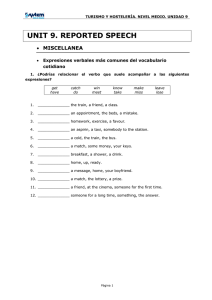unit 5 - reported sp... - Horarios de los centros asociados de la uned
Anuncio
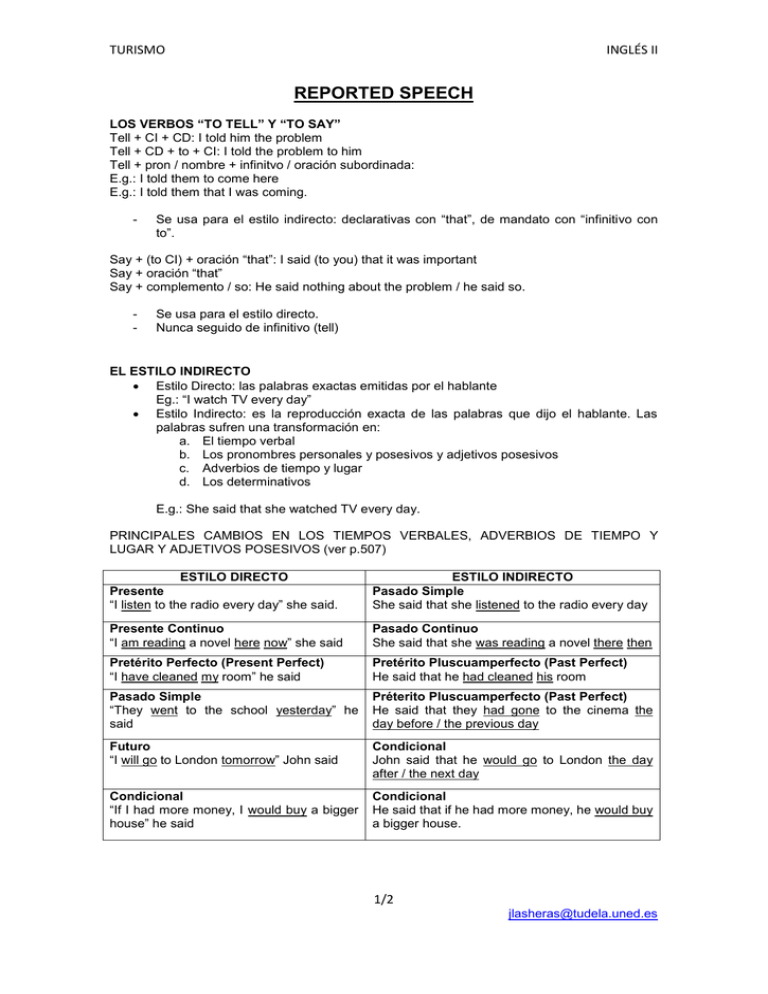
TURISMO INGLÉS II REPORTED SPEECH LOS VERBOS “TO TELL” Y “TO SAY” Tell + CI + CD: I told him the problem Tell + CD + to + CI: I told the problem to him Tell + pron / nombre + infinitvo / oración subordinada: E.g.: I told them to come here E.g.: I told them that I was coming. - Se usa para el estilo indirecto: declarativas con “that”, de mandato con “infinitivo con to”. Say + (to CI) + oración “that”: I said (to you) that it was important Say + oración “that” Say + complemento / so: He said nothing about the problem / he said so. - Se usa para el estilo directo. Nunca seguido de infinitivo (tell) EL ESTILO INDIRECTO Estilo Directo: las palabras exactas emitidas por el hablante Eg.: “I watch TV every day” Estilo Indirecto: es la reproducción exacta de las palabras que dijo el hablante. Las palabras sufren una transformación en: a. El tiempo verbal b. Los pronombres personales y posesivos y adjetivos posesivos c. Adverbios de tiempo y lugar d. Los determinativos E.g.: She said that she watched TV every day. PRINCIPALES CAMBIOS EN LOS TIEMPOS VERBALES, ADVERBIOS DE TIEMPO Y LUGAR Y ADJETIVOS POSESIVOS (ver p.507) ESTILO DIRECTO Presente “I listen to the radio every day” she said. ESTILO INDIRECTO Pasado Simple She said that she listened to the radio every day Presente Continuo “I am reading a novel here now” she said Pasado Continuo She said that she was reading a novel there then Pretérito Perfecto (Present Perfect) “I have cleaned my room” he said Pretérito Pluscuamperfecto (Past Perfect) He said that he had cleaned his room Pasado Simple “They went to the school yesterday” he said Préterito Pluscuamperfecto (Past Perfect) He said that they had gone to the cinema the day before / the previous day Futuro “I will go to London tomorrow” John said Condicional John said that he would go to London the day after / the next day Condicional “If I had more money, I would buy a bigger house” he said Condicional He said that if he had more money, he would buy a bigger house. 1/2 jlasheras@tudela.uned.es TURISMO INGLÉS II ESTILO INDIRECTO: PREGUNTAS Las oraciones interrogativas pierden su estructura típica al pasar a estilo indirecto E.g.: “Is she at home?” > he asked if / whether she was at home E.g.: “What is your name?” > he asked me what my name was. E.g.: “Where do you go after work?” >he asked me where I went after work. E.g.: “What did she do?” > he asked what she had done. ESTILO INDIRECTO: RUEGOS Y PREGUNTAS Las oraciones de ruego y mandato pierden su estructura típica al pasar a estilo indirecto El imperativo pasa a infinitivo E.g.: “Open the window!” > he ordered me to open the door E.g.: “Don’t be late for dinner” > She asked us not to be late for dinner Los verbos del estilo indirecto pasan a ser tell, order, request, beg, urge, etc En estilo indirecto debe haber el complemento de persona a quien va dirigido la orden E.g.: “Run quickly” > he told John to run quickly. En las oraciones condicionales del tipo II no se producen cambios verbales si es muy poco probable la acción pero existe la posibilidad de que sí se cumpla. E.g.: “If you saw him, you wouldn’t recognize him” > he said that if I saw him, I wouldn’t recognize him Si la condición es totalmente hipotética sí se cambian los tiempos verbales E.g.: “If I were you, I would give up smoking” >he said that if he had been me, he would have given up smoking. En las oraciones que se utilizan para expresar una sugerencia, se utilice el verbo “suggest + gerundio” E.g.: “Shall we go to the cinema?” “Let’s go to the cinema” “Do you feel like going to the cinema?” => he suggested going to the cinema “What about going to the cinema?” La expresiones exclamativas E.g.: “What a wonderful concert!” > she exclaimed what a wonderful concert it was 2/2 jlasheras@tudela.uned.es
